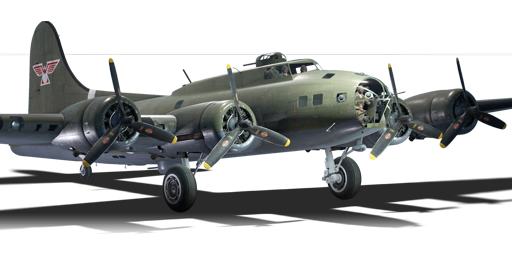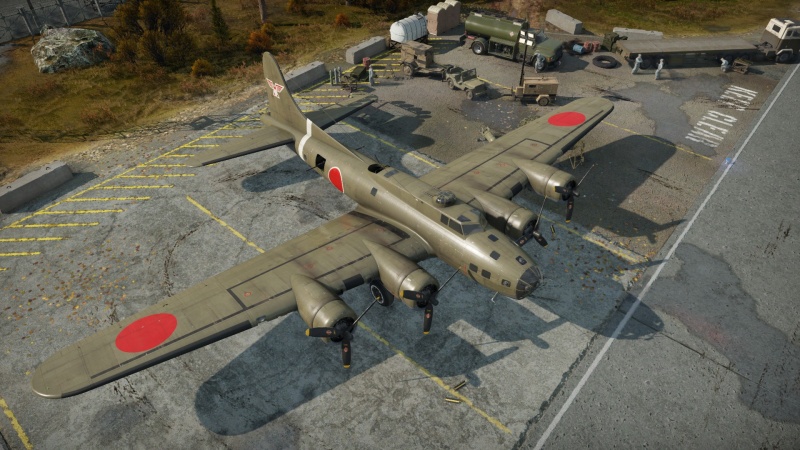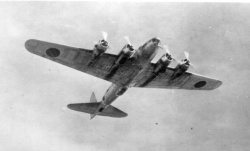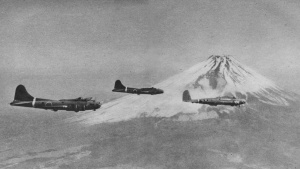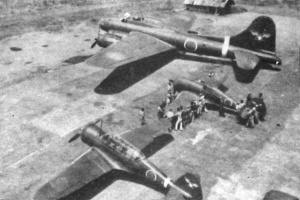Difference between revisions of "B-17E (Japan)"
Inceptor57 (talk | contribs) m (→Pros and cons) |
m (See also section) (Tag: Visual edit) |
||
| Line 200: | Line 200: | ||
== See also == | == See also == | ||
| − | '' | + | '''Related development''' |
| − | * '' | + | * [[B-17 (Family)]] |
| − | * | + | ** [[B-17E]] |
| + | |||
| + | '''Aircraft of similar configuration or role''' | ||
| + | |||
| + | * [[G8N1]] | ||
| + | * [[G5N1]] | ||
== External links == | == External links == | ||
Revision as of 02:17, 2 April 2024
| This page is about the premium Japanese bomber B-17E (Japan). For other versions, see B-17 (Family). |
Contents
Description
The ▅B-17E Flying Fortress, most likely B-17E 41-2471, was one of the few B-17 (D/E) Flying Fortresses that the Japanese captured during World War II, mostly from the Philippines and Java. They repaired and tested some of them. The crew of the B-17E 41-2471, which belonged to the 7th Bomb Group of the USAAF, abandoned it after a crash landing on February 8, 1942, at Djokjakarta, Java. The Japanese found it mostly intact and repaired it with parts from other damaged B-17Es. They flew it to Tachikawa Airfield near Tokyo, where they used it for research and training purposes. The B-17's final fate is unknown, but it was probably destroyed by Allied bombing raids or scrapped after the war.
It was introduced in Update 1.43. The B-17E Flying Fortress, as the name suggests, is intended to be used as a high-altitude level bomber, designed to target enemy airfields, military bases, factories, and other infrastructure crucial to winning the war. Despite its large bomb-load, it is not recommended to target moving ground targets, such as tank formations, unless they are the only targets. This is because of the inaccuracy of the bombs at such high altitude, and since columns will simply disperse when they sight bombs falling. When using the B-17E, it is always best to group up with others in a wedge-like formation for optimal defense against air targets and climb to an altitude of, at least, 4,000 m. A few fighter escorts, would ensure the survival of friendly bombers, only if they adopt fighter-sweep tactics to hunt down enemy fighters converging on the formation.
General info
Flight performance
| Characteristics | Max Speed (km/h at 7,680 m) |
Max altitude (metres) |
Turn time (seconds) |
Rate of climb (metres/second) |
Take-off run (metres) | |||
|---|---|---|---|---|---|---|---|---|
| AB | RB | AB | RB | AB | RB | |||
| Stock | 497 | 483 | 11156 | 36.9 | 37.9 | 5.8 | 5.6 | 600 |
| Upgraded | 523 | 510 | 35.1 | 36.0 | 8.7 | 7.2 | ||
Details
| Features | ||||
|---|---|---|---|---|
| Combat flaps | Take-off flaps | Landing flaps | Air brakes | Arrestor gear |
| ✓ | ✓ | ✓ | X | X |
| Limits | ||||||
|---|---|---|---|---|---|---|
| Wings (km/h) | Gear (km/h) | Flaps (km/h) | Max Static G | |||
| Combat | Take-off | Landing | + | - | ||
| 516 | 290 | 383 | 361 | 249 | ~3 | ~2 |
| Optimal velocities (km/h) | |||
|---|---|---|---|
| Ailerons | Rudder | Elevators | Radiator |
| < 330 | < 310 | < 270 | > 300 |
Survivability and armour
- 6.35 mm Steel plate behind nose gunner
- 6.35 mm Steel plates behind pilots
- 6.35 mm Steel plates behind dorsal gunners
- 6.35 mm Steel plates in front of beam gunners
- 6.35 mm Steel plates in front of tail gunner
- 38 mm Bulletproof glass in front of tail gunner
Modifications and economy
Armaments
Suspended armament
The B-17E (Japan) can be outfitted with the following ordnance:
- 8 x 500 lb AN-M64A1 bombs (4,000 lb total)
- 12 x 500 lb AN-M64A1 bombs (6,000 lb total)
- 6 x 1,000 lb AN-M65A1 bombs (6,000 lb total)
Defensive armament
The B-17E (Japan) is defended by:
- 2 x 12.7 mm M2 Browning machine guns, front dorsal turret (500 rpg = 1,000 total)
- 2 x 12.7 mm M2 Browning machine guns, ventral turret (500 rpg = 1,000 total)
- 2 x 12.7 mm M2 Browning machine guns, tail turret (500 rpg = 1,000 total)
- 1 x 12.7 mm M2 Browning machine gun, rear dorsal turret (500 rpg)
- 1 x 12.7 mm M2 Browning machine gun, 2 x beam turrets (400 rpg)
- 1 x 7.62 mm Browning machine gun, nose turret (500 rpg)
Usage in battles
Generally, the plane's role should not diverge from this norm, as it is ineffective and costly as a low altitude bomber. Survival is an utmost importance to be remembered when using this plane. While one target may be missed, there will always be another opportunity to make another pass once reloaded and repaired. The few M2 machine guns in the nose cannot protect the most vulnerable part of any B-17 - the nose. Protected only by a layer of Plexiglas and almost no armour (excluding the frontal bulkhead, which only covers the pilot/co-pilot's torso), most of the crew critical in the success of the mission, including the pilot, co-pilot, bombardier and navigator would be knocked-out instantly. If targeted by German cannons, most notably, the Mk 108. Just a burst of 30 mm MK 108 placed anywhere on the aircraft , would compromise the crew's survival and even the aircraft's structural integrity.
When facing German fighters and interceptors in realistic battles', it is best to use Omni-purpose or Armour-piercing/Ground Targets ammunition belts for the Browning M2 .50 cal turret machine guns, which is likely to punch through their noses when tailing the B-17E. These ammunition belts are effective at tearing through the engine block of a Focke-Wulf Fw 190D or Messerschmitt Bf 109G, hopefully resulting in an internal engine fire, a pilot snipe, or an inoperable engine for the opponent.
In Simulator mode, the Japanese B-17E offers the same playstyle as the American B-17E with a few special caveats. There are no markers so the Japanese B-17 may be ignored by enemy Allied fighters if they don't look too close, since it is a Flying Fortress. With limited visibility in their cockpit and the light shining their way, it can be difficult to see your Hinomaru roundels. This is a double-edged sword, however. Because as a B-17, you may find yourself under fire by friendly Axis fighters who don't see that you're a friendly plane. It is recommended to tell your team what and where you are so you don't find yourself on the business end of a Ki-84.
Manual Engine Control
| MEC elements | ||||||
|---|---|---|---|---|---|---|
| Mixer | Pitch | Radiator | Supercharger | Turbocharger | ||
| Oil | Water | Type | ||||
| Controllable | Controllable Auto control available |
Not controllable Not auto controlled |
Controllable Not auto controlled |
Combined | Controllable 1 gear |
Auto controlled |
Pros and cons
Pros:
- Large payload
- Powerful air defense capabilities
- Multiple engines, can fly on one if necessary (But with a great loss in altitude and speed)
- Rugged design allows for soaking up damage
- Mostly unaffected by light machine gun fire, and to an extent, heavy machine guns
- Good speed for a bomber of its peers
- Multiple turrets covering almost all angles
- Can quite often return to base with extensive damage
- Pilot and co-pilot, if one of them is knocked out, the B-17E can keep flying
- May be ignored by enemy Allied aircraft and SPAA in Sim
Cons:
- Big target
- Fairly Slow
- Nose is extremely vulnerable, the only armour on the front is the front bulkhead, covering only the pilot and copilot's torso
- Vulnerable to German "Minengeschoß" and > 20 mm gunfire
- Engine fires are common
- Wings are big and thus commonly torn off by gunfire
- Nose protection is extremely limited, try to avoid frontal attacks as much as possible
- May attract friendly fire from friendly aircraft and SPAA in Sim
- No 2000 lb Bombs like the American counterpart
History
After the successful invasion of the Philippines, a team of Japanese engineers from the IJAAF "Koku Gijutsu Kenkyujo" (Army Aviation Technical Research Institute) discovered multiple B-17 wrecks at Clark Field. Salvaging parts from the various wrecks, the engineers managed to piece together a working B-17D, which was flown back to the Japanese home islands in early 1942 for evaluation.
The Japanese soon captured Madioen Field, Java, in March. There, they found multiple B-17E wrecks in repairable condition. Eager to get their hands on a working aircraft, Japanese engineers used the piles of spare parts and captured Allied mechanics to rebuild the B-17s. In early 1943, two rebuilt B-17Es took to the air. Through Singapore, the aircraft flew to the home islands escorted by a fighter squadron and a Nakajima L2D transport, the license-produced DC-3. They were careful to alert AAA gunners along the route so they did not get shot down. The squadron arrived safely in the home islands at Tachikawa airfield in mid-1943.
Aeronautical engineer Major Kazuyuki Saito and his team of engineers and test pilots oversaw evaluation of the American bombers. Since the Japanese had also obtained complete instruction manuals, every component of the B-17 was thoroughly examined and evaluated. Japanese aeronautical engineers such as Mitsubishi engineer Hisanojo Ozawa, dismissed the B-17E as "merely modifications made to an old design" and so the technological systems were deemed more important than the aircraft itself. Of special interest was the famous Norden bombsight, the automatic flight control system, the engine turbochargers and the Sperry Automatic Computing Gunsight. Despite the lack of strategic materials, the Japanese would try to copy what they could to improve their designs.
The IJAAF (Army) would implement turbochargers in various aircraft such as the Ki-83 and the Ki-87, while the IJNAS (Navy) would use an improved bombsight and an advanced fire-control system in the G8N1 Renzan.
The B-17s were frequently repainted with American colors and featured in Japanese war films, sometimes with a captured P-40E as escort.
After a photographic reconnaissance flight over the Tachikawa facility, American intelligence spotted an unknown Japanese four-engined bomber or transport by the runway. It was dubbed the "Tachikawa 104" as they estimated its wingspan was about 104 feet. This estimate was actually really accurate, as the aircraft that they spotted was in fact one of the captured B-17s. (B-17s had a wingspan of 103 feet and 9 inches)[1]. American intelligence did not realize that fact until after the war.
During takeoff for a flight from Fussa in early 1944, one of the B-17Es was caught in a surprise crosswind and its right wing collided with a Ki-49 on the ground. It was damaged beyond repair and was never flown again. The second B-17 was photographed around the same location but later disappeared, and it is possible that the third B-17 was destroyed in the tragic hangar fire at Tokorazawa Airfield.[2]
The postwar records of military vehicles discovered during the Allied Occupation of Japan do not mention finding captured B-17s, nor do they have any existing photographs of them from that period. Where the aircraft ended up after the war's end is a mystery.[3]
Media
- Skins
- Videos
See also
Related development
Aircraft of similar configuration or role
External links
References
- ↑ Dwyer, L., 2018. Boeing B-17 Flying Fortress. [online] Aviation-history.com. Available at: http://www.aviation-history.com/boeing/b17.html [Accessed 6 July 2021].
- ↑ Japanese B-17 Squadron. 2019. [video] Directed by M. Felton. Youtube: Mark Felton Productions.
- ↑ Mikesh, R., 2010. The Suprising Story of Japan's B-17 Fleet. [online] HistoryNet. Available at: https://www.historynet.com/japans-fleet-flying-forts.htm [Accessed 7 July 2021].
| Boeing Aircraft | |
|---|---|
| Aircraft | |
| Fighters | P-26A-33 · P-26A-34 M2 · P-26B-35 |
| Bombers | B-17E · B-17E/L · B-17G-60-VE |
| B-29A-BN | |
| Export | P-26A-34 · B-17G |
| Captured | ▅B-17E |
| Helicopters | |
| Attack | AH-64A · AH-64D |
| Export / Licensed | AH-64A (GR) · ▃AH-64A Peten · AH-64A Peten · ▅AH-64DJP · ▄AH Mk.1 · AHS |
| See Also | Tupolev Design Bureau · Westland Helicopters · Fuji Heavy Industries |
| For Boeing-built ships, see Boeing Marine Branch | |
| Japan bombers | |
|---|---|
| Navy | |
| Carrier-based attack bomber | |
| B5N | B5N2 |
| B6N | B6N1 · B6N2 · B6N2a |
| B7A | B7A2 · B7A2 (Homare 23) |
| Carrier-based dive bomber | |
| D3A | D3A1 |
| D4Y | D4Y1 · D4Y2 · D4Y3 Ko |
| Shipboard Observation seaplane | |
| F1M | F1M2 |
| Land-based Attack bomber | |
| G4M | G4M1 |
| G5N | G5N1 |
| G8N | G8N1 |
| Flying boat | |
| H6K | H6K4 |
| H8K | H8K2 · H8K3 |
| Land-based Bomber | |
| P1Y | P1Y1 |
| Army | |
| Light | Ki-32 |
| Ki-48-II otsu | |
| Heavy | Ki-21-Ia · Ki-21-I hei |
| Ki-49-I · Ki-49-IIa · Ki-49-IIb · Ki-49-IIb/L | |
| Ki-67-I Ko · Ki-67-I otsu | |
| Other countries | ▅B-17E |
| Japan premium aircraft | |
|---|---|
| Fighters | Hagiri's A5M4 · A7He1 · Ki-27 otsu Tachiarai |
| Ki-44-II otsu · ▅Bf 109 E-7 · ▅F4U-1A · Ki-100-II · Ki-44-I 34 | |
| ▅Fw 190 A-5 · A7M1 (NK9H) · Tada's Ki-61-I hei · ▅P-51C-11-NT | |
| J2M4 Kai · A6M5 Ko · A6M6c · J2M5 · Ki-87 · J6K1 | |
| Twin-engine fighters | Ki-96 |
| Jet fighters | F-86F-40 JASDF▅ · T-2 Early · F-4EJ ADTW |
| Strike aircraft | ▄AV-8S |
| Bombers | Ki-21-I hei · Ki-48-II otsu · H8K3 · B7A2 (Homare 23) · ▅B-17E |


